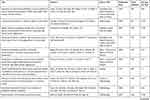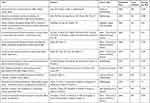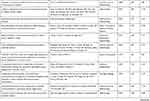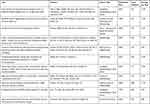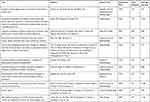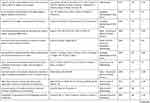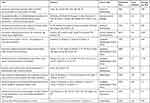Back to Journals » Clinical Ophthalmology » Volume 14
The Top 100 Most-Cited Papers on Intravitreal Injections: A Bibliographic Perspective
Authors Nov E, Moisseiev E
Received 23 June 2020
Accepted for publication 5 August 2020
Published 22 September 2020 Volume 2020:14 Pages 2757—2772
DOI https://doi.org/10.2147/OPTH.S267617
Checked for plagiarism Yes
Review by Single anonymous peer review
Peer reviewer comments 2
Editor who approved publication: Dr Scott Fraser
Eytan Nov,1 Elad Moisseiev1,2
1Department of Ophthalmology, Meir Medical Center, Kfar Saba, Israel; 2Sackler School of Medicine, Tel Aviv University, Tel Aviv, Israel
Correspondence: Elad Moisseiev Department of Ophthalmology
Meir Medical Center, 59 Tshernichovsky Street, Kfar Saba 4428164, Israel
Tel +97297471527
Fax +97297472427
Email [email protected]
Purpose: To analyze the top 100 most-cited papers on pars intravitreal injections.
Methods: Literature search using the bibliographic databases of the ISI Web of Knowledge for all types of publications on intravitreal injections published between 1965 and 2019 in peer-reviewed journals.
Results: Eighty-three of the top 100 papers on intravitreal injections were published in ophthalmology journals, their majority in the top five Q1 leading journals in the field. They originated from 16 different countries, predominantly from the USA (n=52), and were all published in English. These manuscripts cover a wide spectrum of topics but were mostly focused on retinal diseases (n=60) and the use of anti-VEGF or steroid agents (n=75).
Discussion: This bibliographic study provides a unique perspective on the evolution and assimilation of intravitreal injections, from their introduction, through their present role as the most common therapeutic procedure in ophthalmology, to future developments.
Keywords: bibliography, citation, historical, intravitreal injection
Introduction
Intravitreal injections are currently an integral part of the practice of ophthalmology, and are a widely accepted method for intraocular drug delivery. Until only 15 years ago, this procedure was performed much less frequently, and was reserved for delivering antibiotics in cases of endophthalmitis1 or steroids in patients with macular edema.2,3 Following the introduction of anti-Vascular Endothelial Growth Factor (VEGF) agents, the use of intravitreal injections increased exponentially, and they quickly became the most commonly performed procedure in ophthalmology.4
The first anti-VEGF agent to be approved by the FDA was pegaptanib sodium (Macugen, Pfizer), which was effective in improving visual acuity in patients with neovascular age-related macular degeneration (AMD),5,6 but as it only inhibited one isoform of VEGF-A it is no longer used. Soon after ranibizumab (Lucentis, Genentech) was developed, and demonstrated excellent results in treating neovascular AMD in the seminal MARINA and ANCHOR studies.7,8 Other anti-VEGF agents in common use are bevacizumab (Avastin, Genentech), which is extensively used off-label for economic reasons,9 and aflibercept (Eylea, Regeneron). The efficacy and excellent safety profile of anti-VEGF agents administered by intravitreal injections has been demonstrated in numerous large-scale randomized controlled trials, for a wide variety of retinal diseases, including neovascular AMD, diabetic macular edema (DME), and retinal vein occlusions (RVOs).
The introduction of anti-VEGF agents has led to no less than a revolution in the practice of ophthalmology. Not only has the procedure changed from a rarely performed technique to the standard of care in numerous retinal diseases, it also achieved much greater success in visual improvement and maintenance than previously available treatment modalities, such as macular laser and photodynamic therapy (PDT), which became almost obsolete. The purpose of this study was to review the literature on intravitreal injections, identify the 100 most-cited papers on this topic, and provide a bibliographic-historic perspective on this important technique which has had an enormous effect on the practice of ophthalmology.
Methods
A comprehensive search of the bibliographic databases of the ISI Web of Knowledge databases (Web of Science core collection and Medline) was performed for the purpose of this study, by an expert medical librarian. The search was performed using the combination of “intravitreal injection” as the keywords. The search included all peer-reviewed journals, and was not limited to the field of ophthalmology. The search included all publications from 1965 (the earliest year available in the databases) to the present (it was conducted on June 1st 2019). All types of publications were included.
The gross results of the search were then analyzed for their type, journal and year of publication, country of origin and language. The results were listed according to the number of total citations, and were then reviewed individually by the authors. The authors read the abstracts and if additional information was required then the manuscripts were reviewed in full. Manuscripts were excluded if they were found not to focus on intravitreal injections or have any relevance to ophthalmology. For example, a paper in which intravitreal injections of a labeling agent was used as a technique for a neuroscience experiment was not included.10 Included manuscripts had to focus on intravitreal injection as a therapeutic technique, therefore studies in which intravitreal injection was only used as a technique to create a model were also excluded. For example, a study in which intravitreal injections of ouabain were used to induce retinal damage in zebrafish that were later followed for spontaneous regeneration was excluded.11 Using these criteria, a list of the 100 most-cited manuscripts on intravitreal injections was achieved. For each of the manuscripts on the list, the following details were recorded: overall number of citations, mean citations per year since publication, journal name, year of publication, names of first and last authors, number of authors, country of origin, type of manuscript, number of patients/eyes included, the main topic, and the agents used in the intravitreal injection. Manuscript types were categorized into clinical studies, animal studies, laboratory experiments, reviews, meta-analyses, and case reports.
Correlations between continuous variables were analyzed using Pearson’s correlation coefficient, and T-tests and Analysis of Variance (ANOVA) were used to analyze associations between categorical parameters. A P-value of 0.05 was used to determine statistical significance. Data was analyzed using SPSS for Windows version 20.
Results
The overall search results yielded 5486 published manuscripts. Of these, the top 100 manuscripts on intravitreal injections were identified following the analysis and inclusion criteria detailed above.
Overall Literature on Intravitreal Injections
Between January 1, 1965 and June 1, 2019, a total of 5486 manuscripts were published on the topic of intravitreal injections. These papers had a total of 113,588 citations, with a mean of 20.69 citations per paper. The number of publications was very low until 2004, and since that year the number of publications on intravitreal injections and their citations have increased significantly and continuously (Figure 1).
 |
Figure 1 The number of publications on intravitreal injections per year between 1995–2019. Note the significant increase starting in 2004. |
Almost two-thirds (63.7%) of the manuscripts were published in Ophthalmology journals, with 82.9% of them being original articles and 7.5% reviews. 95.5% of the manuscripts were published in English, 2.5% in German, and 1.3% in French. About a third (32.1%) of the manuscripts originated from the USA, followed by China, Japan, and Germany. Details of this gross distribution are presented in Figure 2.
 |
Figure 2 Distribution of the top 100 publications on intravitreal injections, by country of origin (A), language (B), journal field (C), and publication type (D). |
The Top 100 Manuscripts on Intravitreal Injections
The top 100 papers on intravitreal injections are listed in order of descending number of citations in Table 1. The mean number of citations was 235±136, with a median of 173 citations and a range of 128 to 960 citations.
Of the top 100 papers on intravitreal injections, 83 were published in ophthalmology journals. These journals include Ophthalmology (n=17), Retina (n=17), American Journal of Ophthalmology (n=12), Investigative Ophthalmology and Visual Science (n=12), Archives of Ophthalmology (n=9), British Journal of Ophthalmology (n=5), Ophthalmic Surgery and Lasers (n=2), Survey of Ophthalmology (n=2), Australian and New Zealand journal of Ophthalmology (n=2), Graefe’s Archive for Clinical and Experimental Ophthalmology (n=1), Eye (n=1), Experimental Eye Research (n=1), Clinical and Experimental Ophthalmology (n=1), and Current Opinion in Ophthalmology (n=1). Two-thirds (67) of the papers were published in five of the leading Q1 (at the time of publication) journals in Ophthalmology – Ophthalmology, Retina, American Journal of Ophthalmology, Investigative Ophthalmology and Visual Science, and Archives of Ophthalmology. All papers were written in English. Additionally, 15 of the papers were also presented at international meetings registered at the ISI Web of Knowledge databases, most often at the AAO or ARVO annual conferences.
The top 100 manuscripts originated from 16 different countries, with about half of them (52 manuscripts) originating from the US. Other countries of origin included Germany (n=15), Japan (n=6), Australia (n=6), the UK (n=4), Canada (n=3), France (n=2), China (n=2), Spain (n=2), Venezuela (n=2), and Belgium, Brazil, Israel, Lebanon, the Netherlands, and South Korea (n=1 each).
The mean number of authors was 6.1±3.4, with a median of 5 and a range of 1–21. Only one manuscript was published by a single author. There were 16 authors who had more than one first or last authorship on a paper in the top 100 list. These authors are listed in Table 2.
 |
Table 2 Authors Who Had More Than One First or Last Authorship on a Paper in the Top 100 List |
The top 100 manuscripts on intravitreal injections were published between 1974 to 2014. When further divided by decades, there were only two manuscripts published before 1990, 14 manuscripts were published between 1990–1999, 74 manuscripts were published between 2000–2009, and 10 were in 2010 or later. There was no correlation between year of publication and the total number of citations, but a significant correlation was found between later year of publication and a higher mean number of citations per year (P=0.0004).
Almost half (49) of the top 100 manuscripts on intravitreal injections were clinical studies which were conducted on human patients. Of these, 32 (65%) were prospective studies, 14 (29%) were retrospective studies, and three (6%) were observational studies. The number of eyes/patients analyzed in these clinical studies varied between 1–26,905, with a median of 26. Nine (18%) of the studies included 100 or more eyes/patients, while eight (16%) included fewer than 10 eyes/patients. Another 38 manuscripts were basic science papers, conducted on animal eyes or tissues under laboratory settings. The remaining 13 manuscripts included seven reviews, two meta-analyses, and four case reports.
The top 100 manuscripts on intravitreal injections covered a wide variety of topics. Most (60) of the manuscripts were focused on retinal diseases, including diabetic retinopathy (DR) and DME (n=23), neovascular AMD (n=20), RVOs (n=5), retinal ischemia and retinopathy of prematurity (ROP) (n=5), vitreomacular traction (VMT) and macular hole (MH) (n=2), proliferative vitreoretinopathy (PVR) (n=2), polypoidal choroidal vasculopathy (PCV) (n=1), retinitis pigmentosa (RP) (n=1), and lymphoma (n=1). There were also four manuscripts on uveitis and three manuscripts on glaucoma. Nine manuscripts were focused on complications of intravitreal injections, such as intraocular pressure elevation and endophthalmitis. The remaining 24 manuscripts focused on topics other than the injections themselves or specific clinical conditions, such as pharmacology and pharmacokinetic studies on intravitreally injected drugs (n=9), research on the effect of pathways and cytokines other than anti-VEGF and steroids (n=8), mechanisms of action of intravitreally injected drugs (n=3), novel drug delivery techniques (n=2), and gene therapy (n=2). These topics are presented in Table 3.
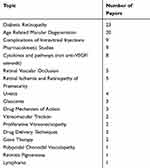 |
Table 3 The Topics of the Top 100 Most-Cited Manuscripts on Intravitreal Injections Included in This Study, in Descending Order of Frequency |
The agents studied in the top 100 manuscripts on intravitreal injections were numerous, but the majority of the manuscripts (75 of them) included anti-VEGF agents (pegaptanib, bevacizumab, ranibizumab, or aflibercept; n=38) or steroids (dexamethasone, triamcinolone, or fluocinolone; n=37). The most common anti-VEGF agent was bevacizumab (n=27; 71%), and the most common steroid was triamcinolone acetonide (n=29, 78%). The remaining 25 manuscripts included other intravitreally injected agents, such as ciliary neurotrophic factor (n=6), ocriplasmin (n=2), methotrexate (n=1), and other factors and antibodies that are not in clinical use.
Discussion
Over the past 15 years, intravitreal injections have become a mainstay in the practice of ophthalmology in general, and especially in the treatment of retinal diseases. Their excellent safety and efficacy profiles proved them to be superior to previous treatments, and they have very rapidly gained popularity and became the most commonly performed procedure in ophthalmology.4 This is the first bibliographic study focused on intravitreal injections, although it should be noted similar works have been done on macular imaging by optical coherence tomography (OCT)12 and pars plana vitrectomy.13 However, in contrast to these two key techniques that have also revolutionized the practice of ophthalmology, the evolution and acceptance of intravitreal injections has been much more rapid.
All manuscripts in the top 100 list were in English, and most of them were published in leading Q1 journals in Ophthalmology (n=67), with the most common country of origin being the USA (n=52). These findings are comparable with previous bibliographic works in ophthalmology.12–15 This is not surprising, as the leading journals are based in the USA and published in English, and their manuscripts are likely to be more cited.
The majority of the top 100 manuscripts on intravitreal injections were published in the decade between 2000–2009 (n=74), with relatively few published prior to 1999 (n=16) or after 2010 (n=10). The first explanation for this finding is that the 2000–2009 decade was the time in which the pivotal studies that established the clinical efficacy of intravitreal injections of anti-VEGF agents (as well as steroids) were published. The works that introduced agents such as bevacizumab, ranibizumab, and triamcinolone acetonide as therapeutic modalities for numerous retinal conditions became landmark papers, with a high rate of citation. This is also reflected in the fact that most of the top 100 manuscripts included these drugs (n=75). A second explanation for this finding is related to the timing of publication. Relatively few studies published before 1999 have focused on these issues, and most of the works from that time that made it into the top 100 list are laboratory experiments, animal studies or small series, that have laid the base for the larger clinical trials of the 2000–2009 decade. Additionally, it is possible that older papers that are expected to have more citations, may have been under-cited as they became common knowledge, forgotten, or refuted.16 In our study, there was no correlation between year of publication and total number of citations, indicating that older papers were not necessarily quoted more frequently than newer ones. Studies published after 2010 require a very high rate of citations per year in order to be included in the top 100 list, as is reflected by the significant correlation between the year of publication and mean number of citations per year (P<0.001). This is compatible with the fact that to achieve a high number of citations comparable to older publications, newer publications have to be cited more often each year since their publication, a phenomenon that was also reported in previous works.13,15
Most of the top 100 manuscripts were focused on retinal diseases (n=60), the most common being AMD, DR, and DME. Also, half of them were clinical studies including human patients. These findings are not surprising, and intravitreal injections are primarily used for the treatment of these common retinal diseases, and have had a huge clinical impact for countless patients with numerous conditions. On the other hand, it is important to note that a significant portion of the top 100 manuscripts is focused on other diseases, novel drug delivery techniques, gene therapy, as well as new therapeutic agents administered by this route, indicating that intravitreal injections are not only integral to the current practice of ophthalmology, but also to ongoing research and development, and will likely continue to be an essential part of ophthalmology in the future.
There are several limitations to this study. We acknowledge that using different databases and search-engines, with different limitations and search definitions, would have resulted in a different list of 100 most cited manuscripts. Our search methodology included all publication types, as citation rates apply to both original research articles as well as reviews, meta-analyses, and other publication types. We also note that the number of citations is not an objective measure of a paper’s quality, accuracy, or validity, but rather of its influence and acceptance in the field. This concept also has its limitations, as newer papers take time to accumulate a high citation rate, and older papers may become less cited with time as they become common knowledge or irrelevant.16 Therefore, we emphasize that this is our list of the 100 most cited papers on intravitreal injections, and not necessarily the best 100 papers. Another limitation is that self-citation was not excluded, as it would have been very complicated to determine this separately for each author in the 100 most cited papers. This is not a significant limitation, as self-citation has been reported to have a low influence on the total citation rate.17
This bibliographic analysis depicts the rapid evolution of intravitreal injections and their effect on ophthalmology, as they transformed from a relatively rare procedure to the most common therapeutic modality in ophthalmology, matching the introcution and rapid prevalence of anti-VEGF agents administered by this route. The list includes many landmark papers and papers by leaders in the field, that have together driven the development of this technique that has truly revolutionized the practice of ophthalmology.
Funding
There is no funding to report.
Disclosure
None of the authors have any proprietary interest in this study. No conflicting relationship exists for any author.
References
1. Results of the Endophthalmitis Vitrectomy Study. A randomized trial of immediate vitrectomy and of intravenous antibiotics for the treatment of postoperative bacterial endophthalmitis. Endophthalmitis Vitrectomy Study Group. Arch Ophthalmol. 1995;113(12):1479–1496. doi:10.1001/archopht.1995.01100120009001
2. Martidis A, Duker JS, Greenberg PB, et al. Intravitreal triamcinolone for refractory diabetic macular edema. Ophthalmology. 2002;109:920–927. doi:10.1016/S0161-6420(02)00975-2
3. Gillies MC, Sutter FK, Simpson JM, Larsson J, Ali H, Zhu M. Intravitreal triamcinolone for refractory diabetic macular edema: two-year results of a double-masked, placebo-controlled, randomized clinical trial. Ophthalmology. 2006;113:1533–1538. doi:10.1016/j.ophtha.2006.02.065
4. Campbell RJ, Bronskill SE, Bell CM, Paterson JM, Whitehead M, Gill SS. Rapid expansion of intravitreal drug injection procedures, 2000 to 2008: a population-based analysis. Arch Ophthalmol. 2010;128:359–362. doi:10.1001/archophthalmol.2010.19
5. Gonzales CR; VEGF Inhibition Study in Ocular Neovascularization (V.I.S.I.O.N.) Clinical Trial Group. Enhanced efficacy associated with early treatment of neovascular age-related macular degeneration with pegaptanib sodium: an exploratory analysis. Retina. 2005;25(7):815–827.
6. Chakravarthy U, Adamis AP, Cunningham ET
7. Brown DM, Kaiser PK, Michels M, et al.; ANCHOR Study Group. Ranibizumab versus verteporfin for neovascular age-related macular degeneration. N Engl J Med. 2006;355(14):1432–1444. doi:10.1056/NEJMoa062655
8. Rosenfeld PJ, Brown DM, Heier JS, et al.; MARINA Study Group. Ranibizumab for neovascular age-related macular degeneration. N Engl J Med. 2006;355(14):1419–1431. doi:10.1056/NEJMoa054481
9. Ciulla TA, Rosenfeld PJ. Anti-vascular endothelial growth factor therapy for neovascular ocular diseases other than age-related macular degeneration. Curr Opin Ophthalmol. 2009;20:166–174. doi:10.1097/ICU.0b013e328329d173
10. Lin CP, Tseng WY, Cheng HC, Chen JH. Validation of diffusion tensor magnetic resonance axonal fiber imaging with registered manganese-enhanced optic tracts. Neuroimage. 2001;14(5):1035–1047. doi:10.1006/nimg.2001.0882
11. Fimbel SM, Montgomery JE, Burket CT, Hyde DR. Regeneration of inner retinal neurons after intravitreal injection of ouabain in zebrafish. J Neurosci. 2007;27(7):1712–1724. doi:10.1523/JNEUROSCI.5317-06.2007
12. Kromer R, Ueberschaar J, Schargus M, Druchkiv V, Frings A. The top 100 papers of 25 years of macular imaging using optical coherence tomography. Semin Ophthalmol. 2018;33:772–781. doi:10.1080/08820538.2018.1443219
13. Krauthammer M, Moisseiev E. The 100 most cited articles on vitrectomy: a bibliographic perspective. Ophthalmol Retina. 2020;4(4):361–368. doi:10.1016/j.oret.2019.10.016
14. Ohba N, Nakao K, Isashiki Y, Ohba A. The 100 most frequently cited articles in ophthalmology journals. Arch Ophthalmol. 2007;125:952–960. doi:10.1001/archopht.125.7.952
15. Heng Wong MY, Tan NYQ, Sabanayagam C. Time trends, disease patterns and gender imbalance in the top 100 most cited articles in ophthalmology. Br J Ophthalmol. 2019;103:18–25. doi:10.1136/bjophthalmol-2018-312388
16. Garfield E. 100 citation classics from the Journal of the American Medical Association. JAMA. 1987;257:52–59. doi:10.1001/jama.1987.03390010056028
17. Swanson EW, Miller DT, Susarla SM, et al. What effect does self-citation have on bibliometric measures in academic plastic surgery? Ann Plast Surg. 2016;77:350–353. doi:10.1097/SAP.0000000000000585
 © 2020 The Author(s). This work is published and licensed by Dove Medical Press Limited. The full terms of this license are available at https://www.dovepress.com/terms.php and incorporate the Creative Commons Attribution - Non Commercial (unported, v3.0) License.
By accessing the work you hereby accept the Terms. Non-commercial uses of the work are permitted without any further permission from Dove Medical Press Limited, provided the work is properly attributed. For permission for commercial use of this work, please see paragraphs 4.2 and 5 of our Terms.
© 2020 The Author(s). This work is published and licensed by Dove Medical Press Limited. The full terms of this license are available at https://www.dovepress.com/terms.php and incorporate the Creative Commons Attribution - Non Commercial (unported, v3.0) License.
By accessing the work you hereby accept the Terms. Non-commercial uses of the work are permitted without any further permission from Dove Medical Press Limited, provided the work is properly attributed. For permission for commercial use of this work, please see paragraphs 4.2 and 5 of our Terms.

